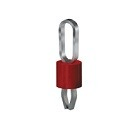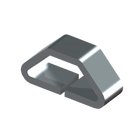Test Points Information
 Test points are electrical terminals used for testing electrical and electronic components. They facilitate the connection of test probes and test fixtures to printed circuit boards. They are used to verify the functionality new components, troubleshoot malfunctioning components, or to recalibrate a device or component.
Test points are electrical terminals used for testing electrical and electronic components. They facilitate the connection of test probes and test fixtures to printed circuit boards. They are used to verify the functionality new components, troubleshoot malfunctioning components, or to recalibrate a device or component.
Test points are differentiated by the type of circuit they interface with. They may be specified as a surface mount (SMT) test point or through-hole mount (THM) test point.
- Through hole mount (THM) test points are mounted to printed circuit boards (PCBs) through holes in the board. They may be further specified by the hole diameter, terminal materials, or package type. Common features for THT test points include snap-fit mounting and color coding.
- Surface mount technology (SMT) test points are compact terminals that are typically wave soldered to the board. They may be specified by size, terminal materials, and packaging type.
Specifications
 Dimensions - SMT test points are specified by length, width, and height. The footprint must match the size of the contacts on the board that they interface with. THM test points are specified by the corresponding hole diameter.
Dimensions - SMT test points are specified by length, width, and height. The footprint must match the size of the contacts on the board that they interface with. THM test points are specified by the corresponding hole diameter.
Terminal materials - Test points are manufactured from a plated strip or wire. Common terminal materials include brass and phosphor bronze that may be nickel, tin, silver, or gold plated.
Maximum current - The maximum current is the electrical load capacity of the test point measured in amperes.
Packing Methods
Test points use several different packing methods including the following:
- Tape reel assemblies consist of a carrier tape with embossed cavities for storing individual components. A cover tape seals the carrier tape in place. The composite tape is wound on a reel that is placed in a corrugated shipping box for transport and delivery.
- Shipping tubes or stick magazines protect components during shipping and provide proper component location and orientation for use with industry-standard, pick-and-place board assembly equipment.
- Test points that are packaged in bulk are distributed as individual parts.
Regulatory Compliance
There are two major European Union (EU) directives that affect test points: REACH and RoHS.
Registration, Evaluation and Authorization of Chemicals (REACH) is the EU standard for supply chain information exchange. The REACH standard provides a portal to facilitate communication with suppliers. If test points are submitted via a trader portal, the supplier portal sends an e-mail to the relevant exporter, requesting registration and providing details about the substances contained in the product. When more complex test points are involved, exporters can also include their own sub-suppliers in the automatic substance query. Restriction of Hazardous Substances (RoHS) is a European Union (EU) directive that requires all manufacturers of electronic and electrical equipment sold in Europe (including test points) to demonstrate that their products contain only minimal levels of the following hazardous substances: lead, mercury, cadmium, hexavalent chromium, polybrominated biphenyl, and polybrominated diphenyl ether. RoHS became effective on July 1, 2006 and continues to govern test points sold in EU nations.
